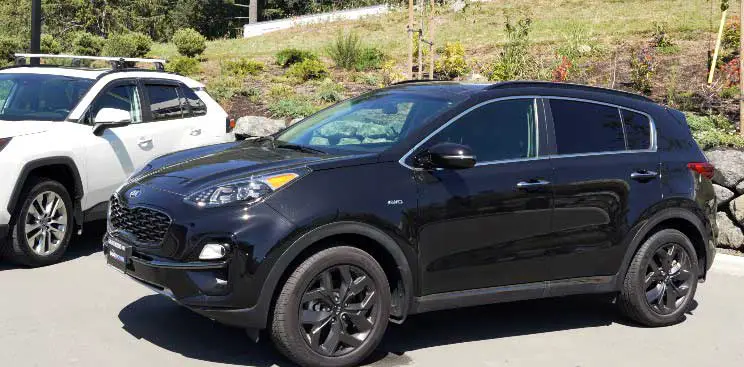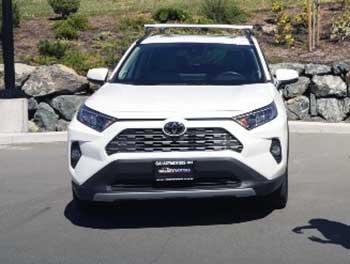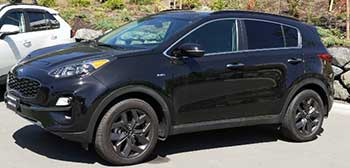When I set out to find the perfect SUV for my family’s needs, the 2025 Kia Sorento and Toyota RAV4 quickly rose to the top of my list. Both are celebrated for their blend of practicality, style, and modern tech, but which one truly fits my lifestyle—or yours?
In this article, I’ll share my firsthand analysis, weighing the pros and cons of each vehicle to help you decide. From performance to comfort, safety to cost, I’ll break it all down in a conversational, easy-to-understand way, ensuring you have the insights needed to choose wisely.

Comparison Table of Kia Sorento vs. Toyota RAV4
| Feature | 2025 Kia Sorento | 2025 Toyota RAV4 |
| Starting MSRP | $33,405 | $31,000 |
| Seating Capacity | Up to 7 (with optional third row) | 5 |
| Cargo Space (Seats Up) | 12.6 cu. ft. | 37.6 cu. ft. |
| Cargo Space (Seats Down) | 75.5 cu. ft. | 75.5 cu. ft. |
| Base Engine | 2.5L 4-cylinder (191 hp) | 2.5L 4-cylinder (203 hp) |
| Hybrid/PHEV Option | Hybrid (227 hp), PHEV (261 hp) | Hybrid (219 hp), PHEV (302 hp) |
| Fuel Economy (Gas) | 23 MPG city / 31 MPG highway | 27 MPG city / 35 MPG highway |
| Fuel Economy (Hybrid) | 37 MPG combined | 30 MPG combined |
| Towing Capacity | Up to 2,000 lbs (gas), 1,010 lbs (PHEV) | Up to 1,500 lbs (gas), 1,750 lbs (PHEV) |
| Safety Rating (NHTSA) | 4/5 stars | 5/5 stars |
| Warranty | 10 years/100,000 miles (powertrain) | 5 years/60,000 miles (powertrain) |
| Infotainment Screen | 8-inch (up to 12.3-inch available) | 6-inch (up to 9-inch available) |
My Journey with SUVs
I’ve always been drawn to SUVs for their versatility. Whether it’s hauling kids to soccer practice, packing up for a weekend camping trip, or just navigating daily commutes, SUVs like the Kia Sorento and Toyota RAV4 seem to check all the boxes.
Over the years, I’ve test-driven countless models, and the midsize SUV segment has become a battleground for innovation. These two stand out because they cater to different needs: the Sorento leans toward family-friendly spaciousness, while the RAV4 emphasizes efficiency and reliability. My goal here is to share my experience, helping you navigate the crowded SUV market with clarity.
Exterior Design and First Impressions
When I first laid eyes on the 2025 Kia Sorento, its bold, broad-shouldered stance caught my attention. Inspired by Kia’s Telluride, it has a commanding presence with a wide grille and sharp taillights that give it a modern, almost American flair. It’s the kind of SUV that feels confident without being overly aggressive, perfect for families who want to make a statement.

The Toyota RAV4, on the other hand, has a rugged, angular look that’s been refined over the years.
Its squarish profile and sleek headlights give it a sporty edge, appealing to those who want a compact SUV with a touch of adventure.
During my test drives, I found the RAV4’s design more approachable for city parking, while the Sorento’s larger frame felt better suited for open roads.
Pros of Sorento’s Exterior:
- Modern, bold design; premium aesthetic; larger presence for family appeal.
Cons of Sorento’s Exterior:
- Wider body can make tight parking trickier.
Pros of RAV4’s Exterior:
- Compact and sporty; easier to maneuver in urban settings; timeless appeal.
Cons of RAV4’s Exterior:
- Less distinctive compared to Sorento’s bold styling.
Interior Comfort and Space

Stepping inside the Sorento, I was impressed by its spaciousness. With an optional third row, it can seat up to seven, making it ideal for larger families.
The front and second rows offer ample legroom—41.4 inches in the front and 41.7 inches in the second row—ensuring everyone stays comfortable on long drives.
The materials feel upscale, especially in higher trims like the SX Prestige, with soft-touch surfaces and available leatherette upholstery.
The RAV4, limited to five seats, feels a bit cozier. Its 41.0 inches of front legroom and 37.8 inches in the rear are decent but fall short of the Sorento’s generosity. However, I appreciated the RAV4’s practical layout, with intuitive controls and a mix of physical buttons and touchscreen functionality. The cargo space with seats up is a standout—37.6 cubic feet compared to the Sorento’s 12.6 cubic feet—making it a champ for grocery runs or gear-heavy outings.
Pros of Sorento’s Interior:
- Roomy for larger families; optional third row; premium materials in higher trims.
Cons of Sorento’s Interior:
- Limited cargo space with third row in use; controls can feel complex.
Pros of RAV4’s Interior:
- Generous cargo space; user-friendly design; durable materials.
Cons of RAV4’s Interior:
- No third-row option; less legroom in the second row.
Performance and Driving Experience
Behind the wheel, the Sorento offers a range of powertrains to suit different needs. The base 2.5-liter four-cylinder engine delivers 191 horsepower, which feels adequate for daily driving but not particularly thrilling. The hybrid (227 horsepower) and plug-in hybrid (PHEV, 261 horsepower) options provide more pep, with the PHEV offering a smooth 32-mile electric range. However, I noticed the Sorento’s handling feels a bit ponderous, requiring slight steering adjustments at higher speeds.
The RAV4’s base 2.5-liter four-cylinder engine pumps out 203 horsepower, giving it a slight edge in responsiveness. Its hybrid (219 horsepower) and PHEV (302 horsepower) variants are zippy, with the RAV4 Prime’s 0-62 mph sprint in just six seconds feeling downright sporty. On the road, the RAV4 feels planted and stable, with a tight 11.4-meter turning circle that makes city driving a breeze. The downside? The engine can get noisy under hard acceleration.
Also Read: Kia Seltos vs. Mazda CX-5
Pros of Sorento’s Performance:
- Diverse powertrain options; smooth hybrid transitions; decent towing capacity (2,000 lbs for gas models).
Cons of Sorento’s Performance:
- Less agile handling; PHEV towing capacity drops to 1,010 lbs.
Pros of RAV4’s Performance:
- Responsive acceleration; excellent handling; strong PHEV performance.
Cons of RAV4’s Performance:
- Noisy engine under load; lower towing capacity (1,500 lbs for gas).
Fuel Efficiency and Eco-Friendliness
Fuel economy is a big deal for me, especially with gas prices fluctuating. The Sorento’s gas model achieves 23 MPG city and 31 MPG highway, which is respectable but not class-leading. The hybrid shines at 37 MPG combined, and the PHEV’s 32-mile electric range means I could handle short commutes without burning gas. Its low CO2 emissions (37 g/km for the PHEV) make it a solid choice for eco-conscious drivers.
The RAV4 takes the crown here. Its gas model gets 27 MPG city and 35 MPG highway, outpacing the Sorento. The hybrid delivers 30 MPG combined, while the RAV4 Prime’s 43-mile electric range and 38 MPG post-electric range make it a fuel-sipping champion. With CO2 emissions as low as 22 g/km, it’s a greener option for daily driving.
Pros of Sorento’s Fuel Efficiency:
- Strong hybrid and PHEV options; low emissions for PHEV.
Cons of Sorento’s Fuel Efficiency:
- Gas model lags behind RAV4; shorter electric range for PHEV.
Pros of RAV4’s Fuel Efficiency:
- Best-in-class gas mileage; longer PHEV electric range; ultra-low emissions.
Cons of RAV4’s Fuel Efficiency:
- Hybrid slightly less efficient than Sorento’s hybrid.
Safety and Driver Assistance
Safety is non-negotiable, especially for family haulers. The Sorento comes equipped with a robust suite of features, including blind-spot monitoring, adaptive cruise control with steering assist, and a unique blind-spot view monitor that displays a live feed in the instrument panel. However, its NHTSA rating is 4/5 stars, and the lack of curtain airbags for the third row is a letdown for a family-focused SUV.
The RAV4 earns a 5/5-star NHTSA rating and a 2023 IIHS Top Safety Pick award, giving it an edge. Its Toyota Safety Sense package includes pre-collision systems, lane-keeping assist, and pedestrian detection. I found the RAV4’s systems intuitive, though the Sorento’s blind-spot monitor felt more innovative during my drives.
Pros of Sorento’s Safety:
- Advanced driver aids; standout blind-spot monitor; five-star Euro NCAP rating.
Cons of Sorento’s Safety:
- 4/5 NHTSA rating; no third-row curtain airbags.
Pros of RAV4’s Safety:
- 5/5 NHTSA rating; IIHS Top Safety Pick; reliable safety tech.
Cons of RAV4’s Safety:
- Less innovative features compared to Sorento’s blind-spot system.
Technology and Infotainment
Tech is where modern SUVs shine, and the Sorento doesn’t disappoint. Its standard 8-inch touchscreen is responsive, with higher trims offering a 12.3-inch display. Apple CarPlay, Android Auto, and Bluetooth come standard, and the available 10-speaker audio system sounds crisp. I loved the digital rear-view mirror and safe exit assist, which add a layer of convenience for family use.
The RAV4’s base 6-inch touchscreen feels dated, though higher trims upgrade to a 9-inch display. It supports Apple CarPlay and Android Auto, and the 360-degree camera is a highlight for parking. However, the interface lacks the polish of the Sorento’s, and the audio system, while solid, doesn’t match Kia’s premium sound.
Pros of Sorento’s Tech:
- Larger, sharper displays; innovative features like digital rear-view mirror; superior audio options.
Cons of Sorento’s Tech:
- Base controls can feel cluttered; learning curve for some features.
Pros of RAV4’s Tech:
- User-friendly interface; excellent 360-degree camera; reliable connectivity.
Cons of RAV4’s Tech:
- Smaller base screen; less premium feel than Sorento.
Pricing and Value
The Sorento starts at $33,405, slightly higher than the RAV4’s $31,000. However, the Sorento’s base trim feels more feature-rich, with options like a power liftgate and dual-zone climate control. Higher trims like the SX Prestige ($48,090) rival the RAV4 Prime XSE ($43,125), but the Kia’s standard features often justify the cost. Plus, its 10-year/100,000-mile powertrain warranty is a major perk.
The RAV4’s lower starting price and strong resale value (losing only 28.7% over five years compared to the Sorento’s 50.1%) make it a budget-friendly choice. The RAV4 Prime’s $7,500 federal tax credit (vs. $6,587 for the Sorento PHEV) sweetens the deal for eco-conscious buyers.
Pros of Sorento’s Value:
- Generous standard features; longer warranty; competitive pricing for features.
Cons of Sorento’s Value:
- Higher starting MSRP; faster depreciation.
Pros of RAV4’s Value:
- Lower starting price; better resale value; larger tax credit for PHEV.
Cons of RAV4’s Value:
- Fewer standard features; shorter warranty.
Reliability and Ownership Costs
Reliability matters when you’re investing in a vehicle for the long haul. The RAV4 has a stellar reputation, with Toyota’s hybrid systems (like those in the Prius) being rock-solid. Maintenance costs are lower, and its 5-year/60,000-mile warranty is decent, though it pales next to Kia’s.
The Sorento has improved in reliability but doesn’t match the RAV4’s track record. Some owners report issues with early models, and projected maintenance costs are higher. However, Kia’s longer warranty offers peace of mind, especially for families planning to keep the SUV for years.
Pros of Sorento’s Reliability:
- Industry-leading warranty; improving reliability scores.
Cons of Sorento’s Reliability:
- Higher maintenance costs; less proven than RAV4.
Pros of RAV4’s Reliability:
- Proven long-term durability; lower maintenance costs.
Cons of RAV4’s Reliability:
- Shorter warranty period.
My Test Drive Insights
During my test drives, the Sorento felt like a mini-van in disguise—perfect for my family of five. The third row, though tight for adults, was a lifesaver for carpooling kids. The ride was smooth, but I noticed the steering required slight tweaks on highways, which wasn’t ideal for long trips.
The RAV4, meanwhile, was a joy in the city. Its compact size and tight turning circle made parking a breeze, and the hybrid’s peppy acceleration was fun. However, the lack of a third row and cramped rear legroom were deal-breakers for my family’s needs.
Which SUV Suits Your Lifestyle?
If you’ve got a big family or need extra seating, the Sorento is your go-to. Its spacious interior, optional third row, and premium features make it a versatile choice for those prioritizing comfort and space. However, if you’re after fuel efficiency, reliability, and a compact footprint for urban adventures, the RAV4 shines. Its lower price and better resale value are hard to beat.
For me, the decision came down to priorities. The Sorento’s roominess won me over for family road trips, but I can’t deny the RAV4’s efficiency and ease of use in daily life. Your choice depends on what matters most—space or savings, luxury or longevity.
Read More: Kia Rio vs. Kia Soul
Frequently Asked Questions (FAQ)
Yes, the Sorento is larger, offering more interior space and an optional third row, while the RAV4 is a compact SUV with only two rows.
The Toyota Highlander is closer in size and seating capacity to the Sorento, as it also offers a third row.
The Kia Sportage is Kia’s direct competitor to the RAV4, sharing a similar compact SUV footprint.
The Sorento is fairly reliable with a strong warranty, but it trails the RAV4 in long-term dependability based on historical data.
Conclusion
Choosing between the 2025 Kia Sorento and Toyota RAV4 isn’t easy, but I hope my experience helps you find clarity. The Sorento’s spaciousness and premium features make it a fantastic pick for families, while the RAV4’s efficiency and reliability appeal to practical buyers. Consider your priorities—space, cost, or eco-friendliness—and test drive both to see what feels right. You can’t go wrong, but the right choice depends on your unique needs. Happy car shopping!

